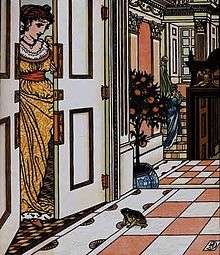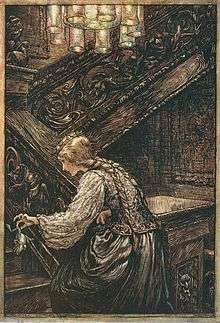The Frog Prince



"The Frog Prince; or, Iron Henry" (German: Der Froschkönig oder der eiserne Heinrich, literally "The Frog King; or, The Iron Heinrich") is a fairy tale, best known through the Brothers Grimm's written version; traditionally it is the first story in their collection. The 2009 Disney film, The Princess and the Frog, is loosely based on this story.
Plot
In the tale, a spoiled princess reluctantly befriends the Frog Prince (meeting him after dropping a gold ball into a pond), who magically transforms into a handsome prince. Although in modern versions the transformation is invariably triggered by the princess kissing the frog, in the original Grimm version of the story the frog's spell was broken when the princess threw it against a wall in disgust.[1]
In other early versions it was sufficient for the frog to spend the night on the princess' pillow.
The frog prince also has a loyal servant named Henry (or Harry) who had three iron bands affixed around his heart to prevent it from breaking in his sadness over his master's curse, but when the prince was reverted to his human form Henry's overwhelming happiness caused all three bands to break, freeing his heart from its bonds.[2]
A Russian folk version "Tsarevna Lyagushka" (The Frog Princess) has the male and female roles reversed: the male prince Ivan Tsarevich discovers the enchanted female frog who becomes Vasilisa the Wise, a female sorceress.
Similar folktales
It is Aarne-Thompson type 440.[3] Other folktales similar to the Frog Prince are:
- "The Frog Prince". The first English translation of the above tale. Edgar Taylor, the translator, not only changed the title, but altered the ending in a substantial and interesting manner.
- "The Wonderful Frog" (W. Henry Jones and Lewis L. Kropf, Hungary).
- "The Tale of the Queen Who Sought a Drink From a Certain Well" (J. F. Campbell, Scotland).
- "The Well of the World's End"
- "The Paddo" (Robert Chambers, Scotland).
- "The Maiden and the Frog" (James Orchard Halliwell-Phillipps, England).
- "The Kind Stepdaughter and the Frog" (W. Henry Jones and Lewis L. Kropf, England).
- "The Frog Prince" (H. Parker, Sri Lanka).
- "A Frog for a Husband" (William Elliot Griffis, Korea).
- "The Toad Bridegroom" (Zong In-Sob, Korea).
The story in popular culture
A popular phrase related to this story is, "You have to kiss a lot of frogs before you find your handsome prince." It is used to encourage those who seek true love. Heiner states that it is unclear when this element was added to the story. Maria Tatar's The Annotated Brothers Grimm merely attributes it to "modern versions of the story", without becoming more specific. Also, the Frog Prince is the true identity of King Harold in the films Shrek 2 and Shrek the Third.
Modern interpretations
- The Frog (1908), directed by Segundo de Chomón, is the first film adaptation of The Frog Prince.
- The Frog Prince was one of the fairy tales featured in Grimm's Fairy Tale Classics under its Grimm Masterpiece Theater season.
- In the second episode of Adventures from the Book of Virtues, Plato the Bison and Annie try to convince their friend Zach to tell his father the truth by telling him three stories, including one about “The Frog Prince.” In this version, the title character was transformed into a frog for lying to a witch and breaking his promise. He is voiced by Jeff Bennett while the princess is voiced by Paige O'Hara.
- 'The Tale of the Frog Prince' was the first story presented by Shelley Duvall's Faerie Tale Theatre in 1982, with Robin Williams as the witty Frog Prince and Teri Garr as the vain princess.
- The Frog Prince is a 1986 film starring John Paragon and Aileen Quinn.
- A musical version of The Frog Prince, written by Dieter Stegmann and Alexander S. Bermange was presented at the Amphitheater Park Schloss Philippsruhe, Hanau, Germany as part of the Brothers Grimm Festival in 2005.
- A chamber opera for children based upon The Frog Prince was recently written by Jacob A. Greenberg for Brown Opera Productions and the Providence Athenaeum.
- Anne Sexton wrote an adaptation as a poem called "The Frog Prince" in her collection Transformations (1971), a book in which she re-envisions sixteen of the Grimm's Fairy tales.[4]
- The Princess and the Frog, a 2009 Disney animated film, loosely based on the 2002 novel The Frog Princess by E.D. Baker which in turn was inspired by "The Frog Prince." The film starred Anika Noni Rose and Bruno Campos and was directed by Ron Clements and John Musker. The Frog Prince book itself was mentioned several times in film, being read to Tiana as a child, and inspiring Prince Naveen (who was transformed into a frog) to suggest Tiana kiss him to break his spell, though seeing as she was only dressed as a princess for Mardi Gras, the kiss fails turning her into a frog as well.
See also
- Henry F. Urban, author of the play Der Froschkönig
Citations
- ↑ Heidi Anne Heiner,"The Annotated Frog King"
- ↑ Lily Owens, ed. (1981). The Complete Brothers Grimm Fairy Tales. p.3. Avenel Books. ISBN 0-517-336316
- ↑ D. L. Ashliman, "Frog Kings: folktales of Aarne-Thompson-Uther type 440 about slimy suitors"
- ↑ "Transformations by Anne Sexton"
References and further reading
- The Prince of the Pond, Jimmy the Pickpocket of the Palace, Gracie the Pixie of the Puddle, a trilogy by Donna Jo Napoli
- The Frog Princess, a novel by E. D. Baker
- Loo, Oliver (2014). The Original 1812 Grimm Fairy Tales. A New Translation of the 1812 First Edition Kinder- und Hausmärchen Collected through the Brothers Grimm. I (200 Year Anniversary ed.). ISBN 9781312419049.
External links
| Wikimedia Commons has media related to Frog Prince. |
| Wikisource has original text related to this article: |
- Nice English version
- Fairyland Illustrated Frog Prince
- SurLaLune Fairy Tale Pages: The Annotated Frog King
- Frog Kings: Folktales about Slimy Suitorss
- Elizabeth Barrette, "Frog Prince" (e-text)
- "Frog Prince 1978 Russian Cartoon"
- Archived audio recording of The Frog Prince, recorded as part of an ArtsSmarts educational project
- Frogprince.ca, presents the Frog Prince for kids
- Auburn and the Frog Prince Storyboard Video